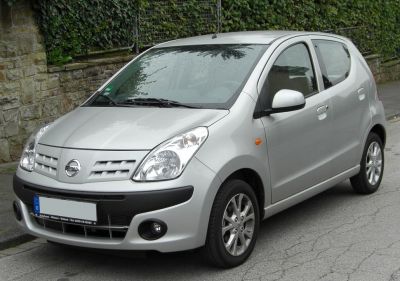 2000 Toyota Vitz I Dimensions, Size & Specs
2000 Toyota Vitz I Dimensions, Size & SpecsMeasurements of the 2000 Toyota Vitz I, engineered for optimal performance and comfort
| Dimensions | |
|---|---|
| Length: | 3610-3630 mm142.1-142.9 in11.8-11.9 ft |
| Width: | 1660 mm65.4 in5.4 ft |
| Height: | 1485-1500 mm58.5-59.1 in4.9-4.9 ft |
| Weight Specifications | |
| Curb Weight: | 810-940 kg1786-2072 lbs |
| Maximal permitted Weight: | 1085-1245 kg2392-2745 lbs |
| Tire Specifications | |
| Rims Sizes: |
|
| Tire Sizes: |
|
The Toyota Vitz I, produced from 1999 to 2005, is a compact hatchback well-suited for urban mobility and efficient driving. Measuring between 3610 mm and 3630 mm (142.1 to 142.9 inches) in length, it offers a compact footprint that makes parking and maneuvering in tight city spaces easy. The vehicle's width stands at 1660 mm (65.4 inches), providing a comfortable cabin width for passengers without compromising agility. Its height ranges from 1485 mm to 1500 mm (58.5 to 59.1 inches), contributing to a balanced profile that supports both aerodynamic efficiency and headroom.
Underneath its compact design, the Vitz I maintains a curb weight range from 810 kg to 940 kg (1786 to 2072 lbs), making it lightweight and responsive while also delivering fuel efficiency. The maximum weight capacity varies between 1085 kg and 1245 kg (2393 to 2745 lbs), allowing for practical daily use including passengers and cargo. The model came equipped with smaller rim sizes, either 13 or 14 inches, paired with tire sizes 155/80 R13 S or 185/55 R14 S, which enhance its comfortable ride quality and road grip.
As a hatchback introduced at the cusp of the 21st century, the first generation Vitz is recognized for its balance of compact dimensions, manageable weight, and practical design. These factors combined contribute to its popularity as a city car that offers sufficient interior space while maintaining ease of driving.
In summary, the Toyota Vitz I offers an excellent blend of compact size and practical features, making it a reliable choice for those seeking a small hatchback with a responsive and efficient design. Its size dimensions and light weight support everyday urban driving needs while still providing room for passengers and luggage.
Discover the standout features that make the 2000 Toyota Vitz I a leader in its class
Have a question? Please check our knowledgebase first.
The Toyota Vitz I, produced from 1999 to 2005, features compact exterior dimensions ideal for urban driving. Its length ranges between 3610 mm and 3630 mm (142.1 to 142.9 inches), providing a small footprint. The width is consistent at 1660 mm (65.4 inches), making it narrow enough for easy maneuverability. Height varies slightly between 1485 mm and 1500 mm (58.5 to 59.1 inches), striking a balance between headroom and aerodynamic design. These dimensions contribute to the Vitz I's ease of navigation in tight city spaces while still offering a practical interior space for passengers and cargo.
The Toyota Vitz I has a curb weight ranging from 810 kg to 940 kg (1786 to 2072 lbs), which indicates the weight of the car without passengers or cargo but with all necessary operating consumables. Its maximum weight, or gross vehicle weight, spans from 1085 kg to 1245 kg (2393 to 2744 lbs), signifying the total maximum weight the vehicle can safely carry including passengers, cargo, and fuel. These lightweight values make the Vitz I a nimble and fuel-efficient car, easy to accelerate and stop, which enhances both city driving enjoyment and economy. The relatively low weight also helps reduce wear on tires and brakes and improves handling, particularly on urban roads.
A standard single-car garage typically measures around 3 meters wide by 6 meters deep (approximately 9.8 by 19.7 feet). The Toyota Vitz I, with a length between 3610 mm and 3630 mm (about 11.85 to 11.9 feet) and a width of 1660 mm (approximately 5.44 feet), fits comfortably inside a standard garage with ample space on all sides for opening doors and walking around. Its relatively compact size also allows for easier parking maneuvers inside the garage compared to larger vehicles, making the Vitz I well suited to residential parking spaces that follow standard dimensions.
The Toyota Vitz I supports rim sizes of 13 and 14 inches and tire sizes including 155/80 R13 S and 185/55 R14 S. The smaller 13-inch rims paired with 155/80 tires generally provide a cushier ride due to higher sidewalls, which absorb road imperfections well. The 14-inch rims with 185/55 tires offer a sportier feel with better cornering response and grip on the road due to their wider tread and lower sidewalls, albeit with a slightly firmer ride. These options allow owners to prioritize comfort or handling depending on their driving preference, with both setups maintaining the balance Toyota aimed for in the Vitz I's tuning.
The Toyota Vitz I's height ranges from 1485 to 1500 mm (58.5 to 59.1 inches), which provides decent headroom for front and rear passengers within a subcompact hatchback footprint. This height is engineered to maximize interior cabin volume without compromising the car’s aerodynamic profile. The relatively tall cabin allows for a more upright seating posture, improving comfort on city commutes and short trips. Despite its compact external dimensions, clever interior design ensures adequate legroom and headroom, making it practical for small families or individuals looking for comfort in a small vehicle.
The Toyota Vitz I (1999-2005) was the inaugural generation of the Vitz model, meaning there was no predecessor under the same name. However, it succeeded the Toyota Starlet in many markets. Compared to the Starlet, the Vitz I is slightly larger in all dimensions, offering more interior space, a more modern and rounded design, and improved safety and comfort features. Its size is still firmly in the subcompact category, but the Vitz I introduced a more contemporary hatchback appeal aligning with late 1990s and early 2000s design trends, emphasizing versatility and urban practicality.
In comparison to similar hatchbacks from the late 1990s and early 2000s, such as the Honda Jazz (Fit) and Suzuki Swift, the Toyota Vitz I has comparable dimensions. Its length between 3610 mm and 3630 mm (142.1 to 142.9 inches) and width of 1660 mm (65.4 inches) align well with competitors, making it competitive in terms of interior space and city driving agility. Although some rivals might offer slightly wider or longer bodies, the Vitz's efficient use of interior space and light curb weight helped it maintain an edge in fuel efficiency and maneuverability. Overall, it stood as a strong contender within the B-segment hatchback market of its time.
The compact size of the Toyota Vitz I is ideal for navigating tight city streets and dense urban environments. With a length just over 3.6 meters (about 11.85 feet) and a narrow width of 1.66 meters (5.44 feet), it can easily squeeze into limited parking spaces where larger cars might struggle. Its small turning radius complements these dimensions, enabling quick and precise maneuvers in heavy traffic or crowded parking lots. Furthermore, the lightweight construction aids in fuel efficiency and nimble handling, making daily city driving less stressful and more economical.
The Toyota Vitz I's curb weight ranges from approximately 810 kg to 940 kg (1786 to 2072 lbs), depending on factors such as trim level, engine choice, optional equipment, and market-specific variations. Models equipped with larger engines or additional safety and comfort features tend to be at the higher end of the weight spectrum. Variations in transmission types and differing regional regulations affecting standard fittings can also contribute to curb weight differences. Despite these variations, the Vitz I remains a lightweight vehicle, contributing to its economical fuel consumption and agile handling characteristics.
Despite its compact external dimensions, the Toyota Vitz I offers practical cargo space, optimized by its hatchback body style. The rear hatch allows easy access to the cargo area, which can be expanded by folding down the rear seats. This versatility maximizes usable space for everyday needs such as groceries, luggage, or small furniture pieces. Although not as spacious as larger vehicles, the Vitz I's cargo capacity is well balanced for a subcompact car, making it suitable for urban dwellers who require a practical and efficient vehicle. The clever interior packaging ensures useful storage without compromising passenger comfort.
Discover similar sized cars.

| Production: | 2009-2013 |
|---|---|
| Model Year: | 2009 |
| Length: | 3565 mm140.4 in |
| Width: | 1600 mm63.0 in |
| Height: | 1470 mm57.9 in |

| Production: | 1994-2000 |
|---|---|
| Model Year: | 1994 |
| Length: | 3565 mm140.4 in |
| Width: | 1605 mm63.2 in |
| Height: | 1460 mm57.5 in |

| Production: | 1991-2000 |
|---|---|
| Model Year: | 1991 |
| Length: | 3565 mm140.4 in |
| Width: | 1605 mm63.2 in |
| Height: | 1450-1460 mm57.1-57.5 in |

| Production: | 1999-2003 |
|---|---|
| Model Year: | 2000 |
| Length: | 3615 mm142.3 in |
| Width: | 1660 mm65.4 in |
| Height: | 1500 mm59.1 in |

| Production: | 2020-present |
|---|---|
| Model Year: | 2020 |
| Length: | 3632 mm143.0 in |
| Width: | 1900 mm74.8 in |
| Height: | 1527 mm60.1 in |

| Model Year: | 2020 |
|---|---|
| Length: | 3632 mm143.0 in |
| Width: | 1878-1900 mm73.9-74.8 in |
| Height: | 1532 mm60.3 in |

| Model Year: | 2016 |
|---|---|
| Length: | 3546-3667 mm139.6-144.4 in |
| Width: | 1866-1893 mm73.5-74.5 in |
| Height: | 1488-1519 mm58.6-59.8 in |

| Production: | 2009-2016 |
|---|---|
| Model Year: | 2009 |
| Length: | 3620 mm142.5 in |
| Width: | 1894 mm74.6 in |
| Height: | 1506 mm59.3 in |
